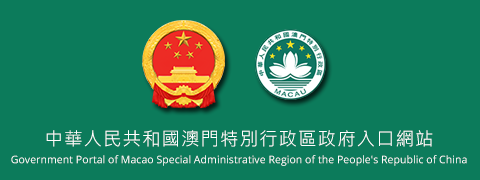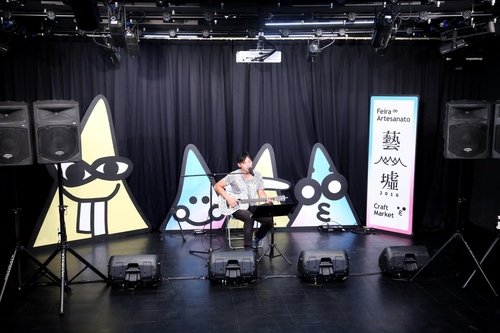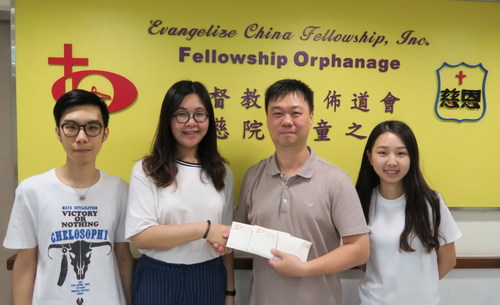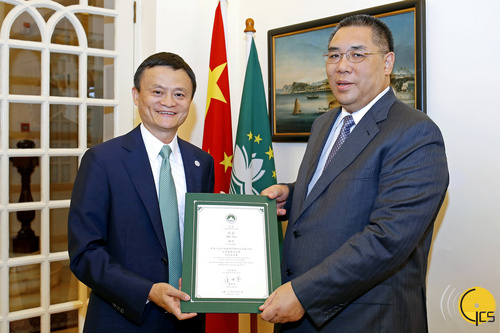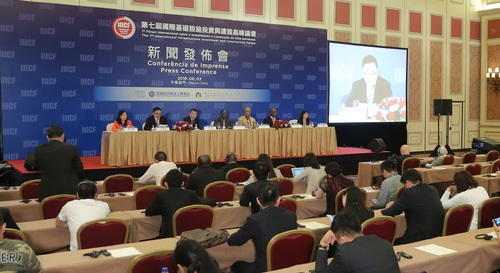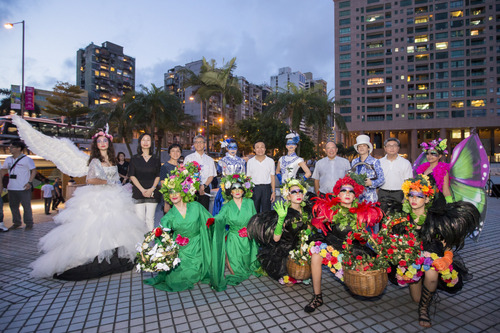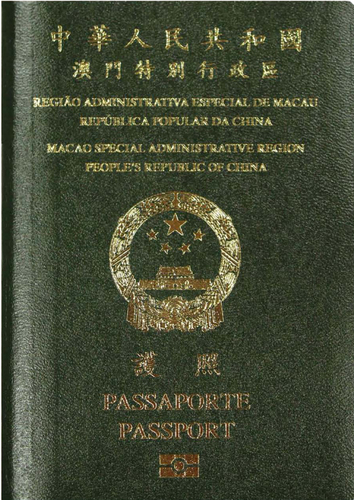Macao SAR Government Portal
News
“Art Fair @5 Outubro Street” and “Nam Van Lake Family Craft Market” are held concurrently this weekend
Organised by the Cultural Affairs Bureau (IC) and co-organised by the Civic and Municipal Affairs Bureau (IACM), the “Art Fair @5 Outubro Street” will be held this Saturday and Sunday, 11 and 12 June, at the Hong Kung Temple Square. In addition, the “Nam Van Lake Family Craft Market” will be held daily from today until 12 June at the Nam Van Lake Plaza. Both activities feature a rich variety of programmes. The public is welcome to participate and buy their favourite creative products, take part in handicrafts workshops and music performances, enjoying a pleasant cultural weekend. The Fair @5 Outubro Street will be held this Saturday and Sunday, from 3pm to 8pm, at the Hong Kung Temple Square, where a total of 36 stalls operated by cultural and creative entities from Macao and Hong Kong will display and sell their original handicraft products and creative food. The Art Fair features various creative products, including leather goods, porcelain, silver accessories, fabric artwork, eco-friendly products and natural beauty products. Some stalls also offer on-site creations, sharing with visitors their passion and talent for creative work. The Fair also features mini-concerts with singers from Hong Kong and Macao who will enliven the atmosphere at the venue. Furthermore, to create a synergy with the Anim’Arte NAM VAN project and the 2016 Macau International Dragon Boat Races, the “Nam Van Lake Family Craft Market” (an extension of the Tap Siac Craft Market) is held at the Nam Van Lake Plaza from today until 12 June, from 11am to 10pm, featuring 20 stalls, handicrafts workshops and music performances. Residents and tourists are welcome to participate in these events. For more information about the craft market, please visit the Macao Cultural and Creative Industries Website (www.macaucci.com), the Tap Siac Craft Market page on Facebook (www.facebook.com/TapSeac.Artfair), or the Cultural Affairs Bureau website (www.icm.gov.mo). For enquiries please contact Ms. Wong through tel. no. 2892 4040 during office hours.
…
UM Prof Da Hsuan Feng receives Kwoh-Ting Li Memorial Medal Award
Prof Da Hsuan Feng, director of global affairs and special advisor to rector at the University of Macau (UM), on 28 May received the 2016 Kwoh-Ting Li Memorial Medal Award for his contributions to education in the Asia-Pacific region. The award was presented to Prof Feng by Dr Raymond T Yeh, a co-founder of the Society for Design and Process Science, who is also a world renowned computer scientist and entrepreneur. ‘I am deeply honoured by this recognition,’ says Prof Feng. ‘There is no doubt in my mind that Taiwan’s economic miracle and subsequent affluence, which helped to enhance people’s quality of life, were largely due to the courageous public policies instituted by several individuals. Kwoh-Ting Li was the most notable of them.’ Prof Feng has accumulated three decades of academic and corporate experience in the United States, where he built a broad and strong global network. He was M Russell Wehr Chair Professor of Physics at Drexel University in Philadelphia, director of the Division of Theoretical Physics of the United States National Science Foundation, vice president of the University of Texas at Dallas, and vice president of the Fortune 500 Science Applications International Corporation (SAIC). In the past nine years in Asia, besides his job at UM, Prof Feng has also served as a senior vice president of two top universities in Taiwan, namely Cheng Kung University and Tsing Hua University, where he was deeply involved in creating a dialogue for university autonomy. In addition, Prof Feng put a lot of effort in promoting intellectual collaborations between Taiwan and mainland China, most notably the collaboration between Tsinghua University in Beijing and Tsing Hua University in Taiwan, and the exchange of Minnan culture between the southern part of Taiwan and Xiamen city in mainland China. He also proactively engaged with academic institutions in India and Europe, and has lectured at nearly all corners of Asia Pacific and South Asia. The Kwoh-Ting Li (KTL) Memorial Medal Award was established in 2012 as a special honour to the speakers of KTL Memorial lecture at international conferences of the Academy of Transdisciplinary Learning and Advanced Studies. This year’s conference was held in Xi’an Jiaotong – Liverpool University in Suzhou, mainland China.
…
Policy that only Macao ID holders can be casino dealers unchanged
The Government will not change – during its current term – its policy of allowing only Macao ID holders to be employed as card dealers in Macao’s casinos. For a long-term, healthy development of the city’s gaming industry, the Government is stepping up efforts to optimise gaming-related regulation, and to strengthen supervision of gaming operators, in a bid further to improve the operation of Macao’s casinos. The Government is committed also to the promotion of responsible gaming. It is additionally monitoring whether gaming operators are offering on-the-job training to Macao ID holders working in integrated resorts in such a way as to improve those employees’ upward career mobility or their horizontal mobility within their respective companies.
…
Consumer Council conducts price survey on selling prices of fresh pork and vegetables from Zhuhai, HK, and Macao
For the implementation of Section 2b), Article 10, Law 4/95/M of 12 June, Consumer Council collects prices of fresh pork and vegetables from wet markets and supermarkets for consumers’ reference. Collected data are used for comparing with the selling prices of the same products from Zhuhai and Hong Kong. The relevant data has been uploaded to the Council’s website for consumers’ reference. The specific price surveys on fresh pork and vegetables are now available on the Council’s website (www.consumer.gov.mo), iPhone & Android ‘Supermarket Price Information Platform’ app, and the Council’s WeChat Account page. The relevant surveys include selling prices of local fresh pork, and comparison on the respective selling prices rom Zhuhai, HK, and Macao. For enquiry, please call 8988 9315.
…
IFT students hold Terra Madre 2016 to raise awareness of healthy eating habits
From January to May 2016, Tourism Event Management Year 2 students of the Institute for Tourism Studies (IFT) undertook an educational project, Terra Madre 2016, which was self-financed and geared towards raising awareness about healthy eating habits. Their audiences was 4 classes of P5 students from the Macau Anglican College. Terra Madre refers to the terms “Mother Earth” and is one of the motto used by the International Slow Food Movement to promote education in the fields of food and beverage. In a city such as Macao where there is no farm, there is a need to emphasise where food items come from and how they can be best utilised to the benefit of one’s body and mind. More than a hundredP5 children and their teachers from the Macau Anglican College enjoyed a drama staged by the IFT students followed by a series of games and workshops in the covered area where they could prepare healthy food items, collected some plants to grow at home and played games on different themes. In the process, the event raised funds of MOP18,605.10 that was given to support the educational goals and extra-curricular activities of the Fellowship Orphanage of Evangelize China Fellowship, a registered local charity in Macao. Established in 1995, the Institute for Tourism Studies, Macao (IFT) offers the most extensive selection of tourism and hospitality related bachelor degree programmes in Macao, and about twenty thousand participants attend its vocational and professional training courses annually. IFT collaborates with 97 universities and tourism organisations around the world, and builds strong links with 500 leading tourism and hospitality corporations to offer internship opportunities to its students. Being the first institution accredited by the UNWTO.TedQual Certification System for tourism education, IFT has now 7 bachelor degree programmes with the Certification. Currently, the Institute has the most number of bachelor degree programmes certified under the System of any tertiary education establishment worldwide. IFT has received the Medal of Merit in Tourism from the Macao SAR Government, and won twice the Gold Award in ‘Education and Training’ from the Pacific Asia Travel Association (PATA).
…
Government explores more ways to cultivate young talents, says CE
Cultivating the talents of young people is a key policy direction in Macao. The Government is committed to exploring new avenues to achieve this, in order to create better conditions and opportunities for development among young people. The Chief Executive, Mr Chui Sai On, made the comments on Monday (6 June) during a meeting at Santa Sancha with the President of the General Association of Zhejiang Entrepreneurs and also Executive Chairman of Alibaba Group, Mr Ma Yun. The Government had previously invited Mr Ma to be a consultant, respectively, to Macao’s Economic Development Council and Macao’s Science and Technology Council. On Monday, the Chief Executive thanked Mr Ma for taking up that position, and presented him with an appointment certificate. Mr Ma was in Macao for the founding ceremony of the Association of Zhejiang Entrepreneurs of Macao, and for a sharing session with local young people. Mr Ma’s vision for Macao’s development and for the future of young people had attracted much attention, said Mr Chui. During the meeting, Mr Ma shared his views on: Macao’s development; how to build a smart city in terms of information technology; his aspirations for young people’s development; the world’s economy; and the development of technology. Macao has a great number of development opportunities, such as those arising from its special links to the Portuguese-speaking countries, said Mr Ma. Such a bridging role would further help Macao participate – via the Internet – in the world economy and in the creation of new technology. Mr Ma added he was pleased to provide Macao’s young people and entrepreneurs with greater opportunities to exchange knowledge and experiences with Zhejiang companies. Officials attending the meeting included: the President of the Legislative Assembly, Mr Ho Iat Seng; the Secretary for Economy and Finance, Mr Leong Vai Tac; the Secretary for Transport and Public Works, Mr Raimundo do Rosário; and the Chief-of-Office of the Chief Executive’s Office, Ms O Lam. Representatives of the General Association of Zhejiang Entrepreneurs present at the meeting included: the Executive Chairman, Mr Shen Guojun; and Vice Presidents Mr Zheng Jianjiang and Mr Tsim Yiu-leung. Representatives of the Association of Zhejiang Entrepreneurs of Macao at the meeting included: the President, Mr Liao Chun Rong; the Chairwoman, Ms Ho Teng Iat; and the Chair of the Supervisory Board, Ms Paula Ling Hsião Yun.
…
Monetary and financial statistics – April 2016
According to statistics released today by the Monetary Authority of Macao, money supply retreated in April. As total deposits dropped, the overall loan-to-deposit ratio of the banking sector rose from a month earlier. Money supply Currency in circulation grew 0.1% while demand deposits dropped 14.1%. M1 thus decreased 11.3% from one month earlier. Concurrently, quasi-monetary liabilities rose 0.2%. The sum of these two items, i.e. M2, decreased 1.3% to MOP463.7 billion. On an annual basis, M1 and M2 dropped 5.7% and 5.8% respectively. The share of Pataca (MOP) in M2 stood at 30.7%, up 0.4 percentage points month-to-month or 3.8 percentage points year-on-year. The share of Hong Kong Dollar (HKD) in M2 was 51.2%, down 0.5 percentage points month-to-month but unchanged from a year ago. The share of Chinese Yuan (CNY) was 6.1%, up 0.2 percentage points month-to-month but down 5.5 percentage points year-on-year. The share of United States Dollar (USD) was 9.5%, down 0.2 percentage points month-to-month but up 1.4 percentage points year-on-year. Deposits Resident deposits decreased 1.4% from the preceding month to MOP451.0 billion. Of which, MOP, CNY and other foreign currency deposits increased at respective rates of 0.1%, 2.6% and 0.6% whereas HKD and USD deposits decreased 2.3% and 3.5% respectively. Non-resident deposits kept virtually stable at MOP289.4 billion. Public sector deposits with the banking sector increased 1.7% to MOP150.8 billion. As a result, total deposits with the banking sector dropped 0.4% from a month earlier to MOP891.2 billion. The shares of MOP, HKD, CNY and USD in total deposits were 20.5%, 47.0%, 7.9% and 21.5% respectively. Loans Domestic loans to the private sector increased 0.4% from a month ago to MOP395.5 billion. Among which, MOP113.3 billion was MOP-denominated, MOP259.6 billion was denominated in HKD, MOP2.5 billion was denominated in CNY and MOP17.1 billion was denominated in USD, representing 28.6%, 65.6%, 0.6% and 4.3% of the total respectively. On the other hand, external loans dropped 0.4% to MOP367.1 billion; of which, loans denominated in MOP, HKD, CNY and USD accounted for 1.7% (MOP6.3 billion), 26.2% (MOP96.1 billion), 16.5% (MOP60.4 billion) and 48.3% (MOP177.5 billion) respectively. Operating ratios At end-April, the loan-to-deposit ratio for the resident sector grew 0.7 percentage points from the previous month to 65.7%. The ratio for both the resident and non-resident sectors rose 0.4 percentage points to 85.6%. The one-month and three-month current assets to liabilities ratios stayed at relatively high levels of 61.3% and 58.2% respectively. The non-performing loan ratio, an indicator for bank asset quality, was 0.1%, virtually unchanged from one month earlier and one year ago.
…
IIICF Promotes Cooperation between Industrial and Financial Sectors, Macao Becomes Platform for Enterprises ‘Going Global’
Jointly hosted by China International Contractors Association and Macao Trade and Investment Promotion Institute (IPIM), under the guidance of the Ministry of Commerce of PRC, the Secretariat for Economy and Finance of Macao SAR Government and the Liaison Office of the Chinese Central Government in the Macao SAR, the 7th International Infrastructure Investment and Construction Forum (7th IIICF), which lasted for two days in Macao, was successfully concluded today (June 3rd). More than 1,400 participants from 60 countries and regions attended the forum, which arranged 14 cooperation agreements and cooperation memoranda, building an international ‘Going Out’ platform for enterprises from Mainland China and Macao. The host parties of this forum jointly held a press conference on the closing day of IIICF. Fang Qiuchen, the president of China International Contractors Association and Jackson Chang, the president of IPIM, gave a general description as well as on the effectiveness of this year’s forum. Counselor from the Department of American and Oceania Affairs of the Ministry of Commerce of China, James Wainaina Macharia, the Minister of Transport and Infrastructure of Kenya, Viraphonh Viravong, the Vice Minister of Energy and Mining of Laos, Xu Yingzhen, and Denys Denya, executive vice president of the African Export-Import Bank, shared the achievements as the participating units respectively. 8,000 Elites from more than 100 countries and regions involved in the 7th IIICF Jackson Chang, the president of IPIM pointed out that IIICF continuously promoted the fusion of regional economy as well as the development of the related industries in Macao, it strengthened the cooperation with fraternal provinces and regions in the Pan-PRD and further highlighted the important function of Macao as a service platform for trade and economic cooperation between China and Portuguese-speaking countries. He stressed that there were totally about 8,000 industry representatives and experts from over 100 countries and regions that participated in the 7 consecutive forums. During the signing ceremony this year, a total number of 14 cooperation agreements and memoranda were signed among China and foreign countries; Macao enterprises and business associations also reached agreements with relevant units at home and abroad. Furthermore, over 120 representatives of Pan-PRD 9+2 Region attended the forum, enhancing the joint communication and discussion of cooperation opportunities among Pan-PRD enterprises, countries along “The Belt and Road” and enterprises from Portuguese-speaking countries. More than 1,400 participants setting a new record of size in this year’s forum Fang Qiuchen, the president of China International Contractors Association, said that four enhancements were achieved in this year’s forum, regarding the aspects of forum’s International influence, function of International platform, the capability to drive developments of infrastructure and related industries as well as participation from Macao industries. He pointed out that the size of the forum, the participation scope and the status of participants and guests were all enhanced in this year’s forum. The forum this year attracted more than 1,400 participants, among which there were 65 groups/delegations at home and abroad and 48 groups/delegations from International organizations, industrial associations and Chinese provincial and municipal commerce departments; the attendees represented over 600 enterprises in more than 60 countries and regions, covering both the upstream and downstream chain of the infrastructure industry; nearly 50 above vice-ministerial level guests from over 30 countries and regions as well as senior executives from over 50 World Top 500 enterprises attended the forum this year. Multiple channels to help enterprises ‘going global’ This year’s forum held 37 special themed events including themed forums, parallel forums, business recommending and matchmaking events and round table dialogue sessions. More than 140 business meetings took place, and 14 cooperation agreements were signed, such as projects for the construction of highways in Madagascar, affordable housing estates in Mozambique, housing reconstruction project in Ecuador and more. An international platform was built for the ‘Going Global’ of enterprises from Mainland China and Macao. Highlighting the advantage of Macao as the economic cooperation platform between China and Portuguese-speaking countries The Monetary Authority of Macao and the Association of Returned Overseas Chinese Macao became the co-organizers for the first time. 6 local co-organizers jointly worked together, covering economic and trade cooperation between China and Portuguese speaking countries, Macao industry and commerce, financial service industry, construction industry and so on. During the parallel session, a high-level seminar on “China-Portuguese speaking countries financial and international industrial capacity cooperation” was held, Ministers of infrastructure from Portuguese-speaking countries and senior executives from international financial institutions and contractor corporations were invited to the seminar and they had a thorough discussion on strengthening bilateral financial and industrial capacity cooperation. Representatives of Portugal, Brazil, Angola, Mozambique and Guinea-Bissau attended the forum, which gave full play to the function of Macao as the economic and trade service platform between China and Portuguese-speaking countries. Seeking common development in infrastructure with 15 Latin American and Caribbean countries Xu Yingzhen, from the Department of American and Oceania Affairs of the Ministry of Commerce of China, said during the conference that the Second Edition of China-LAC Infrastructure Cooperation Forum had attracted 11 officials of ministerial or higher rank from 15 Latin American and Caribbean countries. The representatives from various sectors communicated in depth on how to be better complementary to one another and achieve common development in infrastructure and capacity cooperation; the representatives also shared information regarding the recent infrastructure plans and projects aligned with the rules of the China-Latin America Cooperation Fund and Chinese credit insurance policies toward Latin America. Countries along “The Belt and Road” had a rich harvest during the Forum Minister of Transport and Infrastructure of Kenya, James Wainaina Macharia, and Vice Minister of Energy and Mineral Resources of Laos, Viraphonh Viravong, respectively shared their gains from this forum and their cooperation with China in infrastructure. The Executive Vice-President of African Import and Export Bank, Denys Denya, introduced the work of international financial institutions on promoting the collaboration of industry and finance and reinforcing financial innovation. In addition, he expressed high recognition for the huge impact that the forum had presented on boosting international infrastructure cooperation. The 8th International Infrastructure Investment and Construction Forum will be held in Macao on 1-2 June 2017.
…
Entities jointly forge the brand new landmark for leisure, culture and creativity in synergy “Anim’Arte Nam Van” comes into spotlight
Jointly developed by four entities under the Secretariat for Social Affairs and Culture of the Macao Special Administrative Region Government in synergy, a new landmark for leisure, culture and creativity known as “Anim’Arte Nam Van” is officially open to the public starting today (3 June). The Secretary for Social Affairs and Culture of the Macao SAR Government, Dr. Alexis Tam, officiated the launch ceremony. A joint project presented by Cultural Affairs Bureau (IC), Sports Bureau (ID), Macao Government Tourism Office (MGTO) and the Institute for Tourism Studies (IFT), “Anim’Arte Nam Van” is open to the public daily starting today (3 June). The Secretary for Social Affairs and Culture of the Macao SAR Government, Dr. Alexis Tam, Director of Department of Culture and Education of the Liaison Office of the Central People's Government in the Macao SAR, Xu Ting, Chief of Office of the Secretary for Social Affairs and Culture, Ip Peng Kin, President of IC, Ung Vai Meng, President of Sports Bureau, Pun Weng Kun, MGTO Director Maria Helena de Senna Fernandes and President of IFT, Fanny Vong, officiated the launch ceremony. Other guests include President of Administrative Committee of Cultural Industries Fund, Leong Heng Teng, Vice President of IC, Chan Peng Fai, Vice Presidents of ID, Lau Cho Un and Lam Lin Kio, and MGTO Deputy Director Cheng Wai Tong, etc. Brand new landmark for leisure, culture and creativity During his speech, Secretary Tam expressed that “Anim’Arte Nam Van” has revitalized the waterfront area of Nam Van Lake and combined a variety of elements ranging from water recreational facility, dining, cultural and creative shops, weekend craft market, exhibition, performances to workshops and more. It not only breathes a new dynamic into the neighborhood but also enables residents and visitors to unwind, relax and experience the beauty of Macao. Progress toward diversity He remarked that in order to transform Macao into a World Centre of Tourism and Leisure, the tourism industry must make steady progress toward diversification. The Secretariat for Social Affairs and Culture has always emphasized the importance of using resources effectively to bring out a greater synergistic effect; while through policy support and cross-sector collaboration, striving to facilitate complementary, reciprocal and closer connections between different fields including cultural exhibitions and performances, cultural and creative industries, sports events and leisure tourism. As an innovative project, “Anim’Arte Nam Van” is a product of interdepartmental cooperation. He hopes that this project can make a great start toward steady developments and gain in popularity among residents and visitors. Cultural and creative products on display and sale “Anim’Arte Nam Van” is equipped with cultural and creative shops, arts pavilion, indoor craft market and book market, handcraft workshops and craft market on weekends as well as graffiti display area and more. Cultural and creative products imbued with Macao’s unique character are on display and sale, which not only is a boon to local cultural and creative industries but also makes a convenient stop-off for residents and visitors to discover local gems. Co-hosted by IC and Macau Artist Society, “Run to Nam Van Lake: Exhibition of the Works by the Young Members of the Macau Artist Society” is also officially inaugurated at “Anim’Arte Nam Van” to showcase a collection of artwork pieces depicting the scenery of Nam Van Lake by 19 young local painters. Tranquil boat ride on the lake The beautiful scenery of Nam Van Lake is refreshing. Pedal boats are available at “Anim’Arte Nam Van” for residents and visitors to enjoy a relaxing ride on the lake. Free activities add great fun Special performances and activities that are free of charge will enliven the leisure hub on weekends including a parade in classic costumes, the puppet show “Eléctrico", Portuguese Fado and Jazz music, face painting, stilt performance, clown act and balloon twisting, promising great fun and delight for residents and visitors, young and old. A taste of slow living Starting on 4 June until early 2017, IFT Café will come into temporary operation as a training ground for students. The leisure café will serve a menu of fine-quality snacks and drinks in European style. Visitors can relish the café delights with a taste of slow living while enjoying the lake scenery. To make great use of the available space in accord with the whole district development, the SAR Government plans to call for public tenders this year to invite merchants to open their business at “Anim’Arte Nam Van”, introducing more cultural and creative shops into the new landmark and offering catering service that serves a greater variety of culinary delights, in order to keep increasing the appeal of “Anim’Arte Nam Van”.
…
Countries/Regions where holders of Macao SAR Passport can get access to by means of e-Visa
The Identification Services Bureau has received confirmation from other countries or regions that holders of the Macao SAR Passport can get access to the relevant countries or regions by means of e-visa. The Identification Services Bureau has finished collating and organizing the relevant information. At present, a total of 9 countries (i.e. Australia, Cambodia, Canada, Colombia, Gabon, India, Kenya, Myanmar and Zambia) have confirmed that holders of the Macao SAR Passport can enter their countries or regions with e-visa. For the information of countries or regions where holders of Macao SAR Passport can get access to by means of e-visa and the relevant formalities of e-visa applications, citizens can visit the website of the Identification Services Bureau (www.dsi.gov.mo/download/E_visa_e.pdf). Online application for e-visa is time-saving. It makes citizens no longer need to pay a visit to the nearby embassies or consulates in person for applying for visas. The Identification Services Bureau will continue to actively promote Macao SAR travel documents, so as to bring greater convenience to citizens travelling abroad.
…
